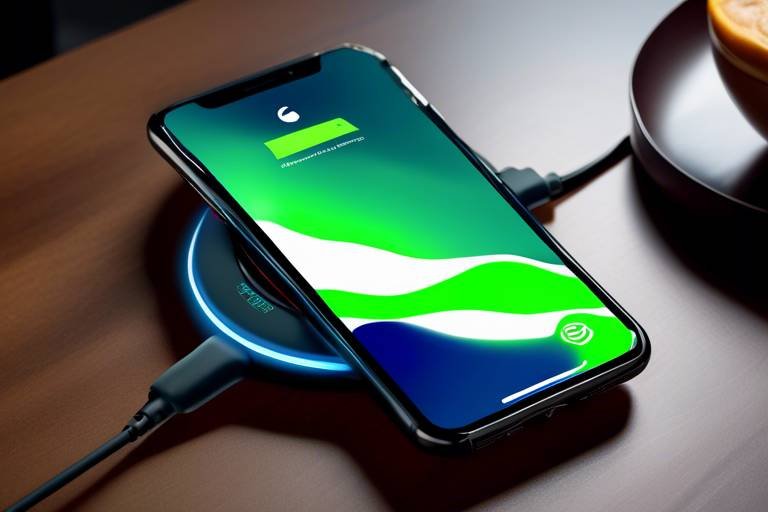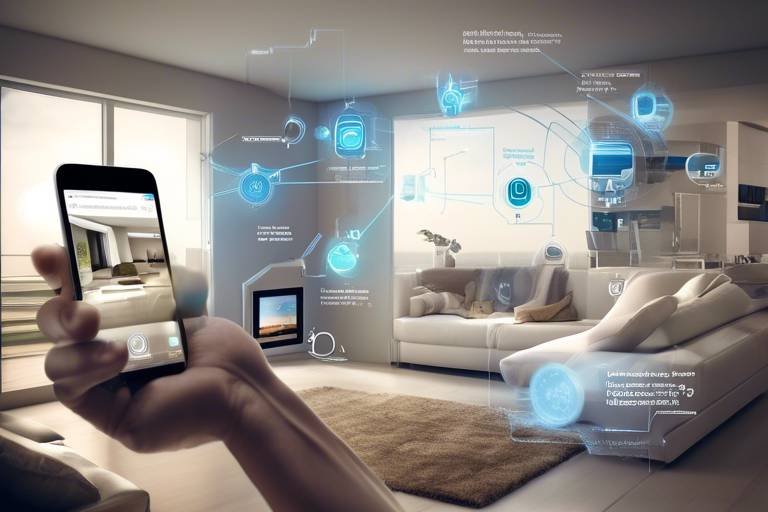Wireless Charging: Powering the Future of Technology?
In a world where convenience reigns supreme, wires seem to be the last thing we want to deal with. Think about it: how many times have you fumbled around for a charging cable while your device is on the brink of dying? Enter wireless charging, a technology that promises to make our lives easier by eliminating the need for those pesky cords. But what exactly is wireless charging, and how has it evolved over the years? This article will take you on a journey through the fascinating evolution, benefits, challenges, and future prospects of wireless charging technology. We’ll explore its impact on various devices and how it has the potential to revolutionize the way we power our gadgets.
Wireless charging isn't a new concept; its roots can be traced back to the late 19th century when inventor Nikola Tesla demonstrated the principles of wireless energy transfer. Fast forward to the 21st century, and we see this technology transforming into a practical solution for our everyday needs. Initially, wireless charging was seen in niche applications, primarily in dental equipment and electric toothbrushes. However, as smartphones became ubiquitous, the demand for more convenient charging solutions surged. Manufacturers began to adopt wireless charging technology, leading to the introduction of Qi standard in 2010, which set the stage for broader adoption across various devices.
To truly appreciate wireless charging, it’s essential to understand how it operates. At its core, wireless charging relies on the principles of electromagnetic induction and resonance. Here’s a simplified breakdown:
- Electromagnetic Induction: This principle involves transferring energy between two coils—one in the charging pad and the other in the device. When an alternating current flows through the coil in the charger, it creates a magnetic field that induces a current in the coil of the device, charging it.
- Resonance: This method allows for more efficient energy transfer over a distance. By tuning the coils to resonate at the same frequency, devices can charge even when they are not perfectly aligned with the charging pad.
These technologies enable us to charge our devices without the hassle of plugging and unplugging cables, making it a game-changer in personal technology.
So, why should you consider switching to wireless charging? Here are some compelling benefits:
- Convenience: Simply place your device on the charging pad, and voila! No more tangled cords or searching for the right cable.
- Reduced Wear: Frequent plugging and unplugging can wear out charging ports. Wireless charging minimizes this wear, extending the life of your devices.
- Improved Safety: With no exposed connectors, there's a lower risk of electrical shorts or damage to the device.
These advantages enhance the overall user experience, making wireless charging an attractive option for tech-savvy individuals.
Despite its numerous benefits, wireless charging isn't without its challenges. One of the main drawbacks is the slower charging speed compared to traditional wired charging. While technology is advancing, many users still find themselves waiting longer for their devices to charge wirelessly. Additionally, compatibility issues can arise, as not all devices support the same wireless charging standards. As we continue to embrace this technology, manufacturers are working diligently to address these limitations and improve charging speeds.
Understanding the various standards that govern wireless charging is crucial for consumers. The most prominent standards include:
| Standard | Overview | Compatibility |
|---|---|---|
| Qi | Developed by the Wireless Power Consortium, Qi is the most widely adopted standard. | Compatible with most smartphones and devices. |
| AirFuel | Focuses on resonant charging, allowing for charging over a distance. | Compatible with select devices, but less common than Qi. |
These standards ensure that devices can charge efficiently and safely, promoting a seamless user experience.
The versatility of wireless charging extends beyond smartphones. It’s making waves in various applications, including:
- Smartwatches: Many wearables now come with wireless charging capabilities, making it easier to keep them powered up.
- Electric Vehicles: Wireless charging technology is being integrated into electric vehicle infrastructure, paving the way for a future where EVs can charge without plugging in.
- Home Appliances: From kitchen gadgets to smart home devices, wireless charging is becoming a standard feature.
This technology is set to enhance our daily interactions with devices, making charging a hassle-free experience.
As technology continues to evolve, the future of wireless charging looks incredibly promising. Innovations are on the horizon, such as faster charging speeds, increased efficiency, and even the potential for charging multiple devices simultaneously. Imagine a world where your phone, smartwatch, and earbuds all charge effortlessly on a single pad. The possibilities are endless, and as we embrace this technology, we can expect to see it become a standard feature in our everyday lives.
In conclusion, wireless charging is more than just a trend; it’s a glimpse into the future of technology. With its myriad benefits, ongoing advancements, and increasing applications, it’s clear that this innovative charging solution is here to stay. As we move forward, embracing wireless charging will not only enhance our user experience but also pave the way for future technological advancements. So, why not cut the cords and join the wireless revolution?
Q: Is wireless charging safe for my devices?
A: Yes, wireless charging is designed with safety in mind. It includes features to prevent overheating and short circuits.
Q: Can I use my phone while it's charging wirelessly?
A: Absolutely! You can use your device while it's charging, just like you would with a wired connection.
Q: Will wireless charging work with my phone case?
A: Most cases are compatible, but it's best to check if your case is specifically designed for wireless charging.

The Evolution of Wireless Charging
Wireless charging has come a long way since its inception. The journey began in the late 19th century when Nikola Tesla demonstrated the possibility of transferring energy without wires using his famous Tesla Coil. While this concept was groundbreaking, it remained largely theoretical for decades, with practical applications only emerging in the 21st century. Fast forward to the early 2000s, and we saw the first commercial implementations of wireless charging technology, primarily in the form of inductive charging pads for electric toothbrushes and other small devices.
As consumer demand for more convenient charging solutions grew, so did the technology. In 2012, the Qi standard was introduced by the Wireless Power Consortium, paving the way for a universal charging standard that could be adopted across various devices. This was a game changer, allowing smartphones and other gadgets to charge wirelessly, eliminating the hassle of tangled cords and damaged charging ports. The adoption of Qi technology by major manufacturers like Apple and Samsung in their flagship devices marked a significant milestone in the evolution of wireless charging.
Today, wireless charging is not just limited to smartphones; it has expanded to encompass a wide range of devices, including smartwatches, tablets, and even electric vehicles. The integration of wireless charging into furniture and public spaces, such as airports and cafes, has made it even more accessible to users. This evolution has been driven by advancements in technology, including improved efficiency, faster charging times, and enhanced safety features.
However, the evolution of wireless charging is not without its challenges. Issues such as heat generation, charging speed, and compatibility among devices continue to be areas of focus for researchers and developers. Nonetheless, the future looks bright as innovations like resonant inductive coupling and magnetic resonance are on the horizon, promising to further enhance the efficiency and versatility of wireless charging solutions.
In summary, the evolution of wireless charging has been a fascinating journey from Tesla's early experiments to the modern-day convenience we enjoy. As technology continues to advance, we can expect even more exciting developments that will further revolutionize how we power our devices.

How Wireless Charging Works
Understanding how wireless charging works can feel like peering into the future of technology. Imagine a world where you can simply place your device down and it starts charging without fumbling with cables. This is made possible through the principles of electromagnetic induction and resonance. These technologies create an invisible connection between your device and the charging pad, making the charging process seamless and efficient.
At its core, wireless charging operates on the principle of transferring energy through electromagnetic fields. Here’s how it generally works:
- Electromagnetic Induction: This is the most common method used in wireless charging. It involves two coils—one in the charging pad and one in the device. When electricity flows through the coil in the charger, it creates a magnetic field. This magnetic field induces a voltage in the coil of the device, allowing it to charge.
- Resonant Induction: This method allows for charging over a slightly longer distance. By tuning both the charger and the device to the same frequency, energy can be transferred more effectively, even if they are not perfectly aligned.
To break it down further, let's visualize the process with a simple table:
| Step | Action | Description |
|---|---|---|
| 1 | Connect Charger | The charger is plugged into a power source, creating a magnetic field. |
| 2 | Place Device | Your device is placed on the charging pad, aligning the coils. |
| 3 | Induction | The magnetic field induces a current in the device's coil, charging the battery. |
| 4 | Completion | Once fully charged, the device stops drawing power, preventing overcharging. |
One of the fascinating aspects of wireless charging is its ability to charge multiple devices at once. Some modern charging pads can handle several devices simultaneously, creating a clutter-free charging station. Just think about how convenient it would be to charge your smartphone, smartwatch, and earbuds all at once, without the hassle of tangled wires!
However, it’s important to note that while the technology is impressive, it does come with some limitations. For instance, wireless charging is generally slower than traditional wired charging. This is due to the energy loss that occurs during the transfer process. But as technology advances, we can expect these speeds to improve, making wireless charging even more appealing.
In conclusion, the mechanics behind wireless charging are both intriguing and revolutionary. By utilizing electromagnetic principles, this technology not only enhances user convenience but also paves the way for a future where charging our devices could be as effortless as placing them down on a surface. So, the next time you see a wireless charger, remember the science that makes your life just a little bit easier!

Benefits of Wireless Charging
Wireless charging technology has ushered in a new era of convenience and efficiency, transforming the way we power our devices. Imagine a world where you can simply place your smartphone down on a charging pad and walk away, without the hassle of tangled cords or searching for an outlet. This is just one of the many benefits that wireless charging brings to the table.
One of the most significant advantages of wireless charging is the convenience it offers. With traditional charging methods, you often find yourself fumbling with cables, especially in low-light situations or when you're in a hurry. Wireless charging eliminates this hassle, allowing you to simply drop your device onto a charging surface and go about your day. This seamless experience is particularly appealing in our fast-paced lives, where every second counts.
Additionally, wireless charging reduces wear and tear on charging ports. Over time, plugging and unplugging your device can lead to damaged connectors and frayed cables. With wireless charging, there's no physical connection to worry about, which means your device's ports remain intact for a much longer period. This not only extends the lifespan of your devices but also saves you money in the long run.
Safety is another critical benefit of wireless charging. Traditional charging methods can sometimes lead to overheating, especially if the device is left plugged in for too long. Wireless charging systems often have built-in safety features that help regulate temperature and prevent overcharging. This means you can charge your devices with peace of mind, knowing that they are protected from potential hazards.
Moreover, wireless charging is becoming increasingly integrated into our everyday environments. From coffee shops to airports, many public spaces now feature wireless charging stations, making it easier than ever to keep your devices powered up on the go. This widespread adoption not only enhances user experience but also promotes a more sustainable approach to energy consumption, as many wireless charging systems are designed to be energy-efficient.
Furthermore, the versatility of wireless charging technology cannot be overlooked. It is not limited to just smartphones; it extends to a wide range of devices, including smartwatches, earbuds, and even electric vehicles. This adaptability opens up a world of possibilities, as manufacturers can create innovative products that leverage wireless charging capabilities.
In summary, the benefits of wireless charging are numerous and impactful. From unparalleled convenience and reduced wear on device ports to enhanced safety and versatility, it's clear that this technology is not just a passing trend. As we embrace the future of charging, we can expect even more exciting developments that will further enhance our daily lives.
- Is wireless charging slower than wired charging?
Generally, yes. Wireless charging can be slower than traditional wired charging, but advancements in technology are continuously improving charging speeds.
- Can I use my phone while it's wirelessly charging?
Yes! Most devices allow you to use them while they are charging wirelessly, just as you would with a wired connection.
- Does wireless charging work with phone cases?
Most phone cases are compatible with wireless charging, but it's advisable to check the manufacturer's recommendations to ensure optimal performance.

Challenges and Limitations
While wireless charging technology has certainly made waves in the world of electronics, it's not without its share of challenges and limitations. One of the most significant hurdles is the issue of charging speed. Compared to traditional wired charging methods, wireless charging tends to be slower. This can be frustrating for users who are accustomed to the quick power-ups that wired chargers offer. Imagine being in a rush and needing to charge your phone, only to find that it takes significantly longer to gain the same amount of battery life wirelessly. It’s like waiting for a slow cooker to make dinner when you could have just used a microwave!
Another challenge is compatibility. Not all devices support the same wireless charging standards, which can lead to confusion and frustration. For instance, while the Qi standard is widely adopted, not all gadgets are compatible with it. This lack of uniformity means that consumers often find themselves stuck with chargers that won’t work with all their devices. It’s akin to having a universal remote that only works with half of your electronics—annoying, right?
Furthermore, there are concerns regarding efficiency. Wireless charging can be less efficient than wired charging, which means that more energy is wasted during the charging process. This inefficiency not only affects charging times but also raises questions about the environmental impact of using more electricity than necessary. In a world increasingly focused on sustainability, this is a significant drawback.
Moreover, heat generation is another limitation that users need to consider. Wireless charging can produce excess heat, which may not only affect the performance of the device being charged but can also lead to potential safety issues. Overheating can damage batteries over time, reducing their lifespan and effectiveness. It's crucial for manufacturers to find ways to mitigate this heat to ensure the longevity of devices.
Lastly, the cost factor cannot be overlooked. Wireless charging pads and accessories can be more expensive than traditional chargers. For many consumers, this added expense may not seem justified, especially if they are already equipped with reliable wired charging solutions. It’s like paying a premium for a fancy coffee when you could just brew a solid cup at home!
In summary, while wireless charging holds immense potential and offers a glimpse into the future of technology, it does come with its set of challenges. Addressing these limitations will be crucial for the technology to gain widespread acceptance and become the norm in our daily lives.
- What are the main challenges of wireless charging?
The main challenges include slower charging speeds, compatibility issues, energy inefficiency, heat generation, and higher costs compared to traditional charging methods.
- Is wireless charging safe for my device?
While generally safe, excessive heat generated during wireless charging can potentially damage your device's battery over time. It's essential to use high-quality chargers and follow manufacturer guidelines.
- Will wireless charging replace wired charging?
While wireless charging is becoming more popular, it may not completely replace wired charging due to its current limitations. However, advancements in technology may help bridge this gap in the future.

Wireless Charging Standards
Wireless charging technology has grown rapidly, but it has also led to the emergence of various standards that govern how devices communicate and charge wirelessly. Understanding these standards is crucial for both manufacturers and consumers, as they ensure compatibility and efficiency in charging. The two most prominent standards currently are Qi and AirFuel.
The Qi standard, developed by the Wireless Power Consortium (WPC), has become the most widely adopted wireless charging standard. It utilizes inductive charging technology, which means it transfers energy through electromagnetic fields between a charging pad and a compatible device. This standard is prevalent in smartphones, smartwatches, and other small electronics. One of the key features of Qi is its ability to support multiple power levels, allowing for anything from slow trickle charging to fast charging capabilities.
On the other hand, AirFuel, which encompasses both inductive and resonant charging, focuses on providing a more versatile charging experience. It allows for charging over greater distances compared to Qi, which is typically limited to a few millimeters. AirFuel's resonant charging technology can charge multiple devices at once, making it an attractive option for public charging stations and automotive applications. However, it has not yet achieved the same level of adoption as Qi.
| Standard | Type | Range | Compatibility |
|---|---|---|---|
| Qi | Inductive | Up to 4 cm | Smartphones, Wearables |
| AirFuel | Inductive/Resonant | Up to 10 cm | Multiple Devices |
While these two standards dominate the landscape, there are other emerging standards worth mentioning. For instance, the Power Matters Alliance (PMA) has also been involved in developing wireless charging technologies, although its influence has waned in favor of Qi and AirFuel. The competition between these standards is crucial, as it drives innovation and improvements in charging efficiency and speed.
As we move forward, the importance of standardization in wireless charging cannot be overstated. It not only ensures that devices can charge seamlessly but also enhances user experience by minimizing frustration with incompatible chargers. Moreover, as more devices embrace wireless charging, we can expect to see an increase in the number of public charging stations, further integrating this technology into our daily lives.
In conclusion, the evolution of wireless charging standards like Qi and AirFuel reflects the ongoing advancements in technology. As consumers, understanding these standards helps us make informed choices about our devices and their charging capabilities. With the potential for greater convenience and efficiency, the future of wireless charging looks bright, and embracing these standards will be essential for widespread adoption.
- What is the difference between Qi and AirFuel? Qi primarily uses inductive charging, while AirFuel incorporates both inductive and resonant charging technologies, allowing for greater flexibility and distance.
- Can I use a Qi charger with an AirFuel device? No, due to the differences in technology, Qi chargers are not compatible with AirFuel devices and vice versa.
- Are all wireless chargers the same? No, different wireless chargers may adhere to different standards, and thus compatibility may vary between devices.

Applications of Wireless Charging
Wireless charging technology has rapidly evolved and is now making its mark across various industries and applications. From our everyday gadgets to groundbreaking innovations in transportation, the ability to charge devices without the hassle of cords is not just a convenience—it's transforming how we interact with technology. Imagine waking up in the morning and simply placing your smartphone on a charging pad, or driving an electric vehicle that charges effortlessly while parked. This is the reality that wireless charging is ushering in.
One of the most prevalent applications of wireless charging is in smartphones. Major brands have adopted this technology, allowing users to charge their devices by just placing them on a compatible charging pad. This eliminates the wear and tear associated with traditional charging ports and creates a seamless experience. Beyond smartphones, wireless charging is also making waves in the realm of smartwatches and fitness trackers. These devices often require frequent charging, and the convenience of simply docking them on a charging surface is a game changer.
But the applications don’t stop there. In the automotive industry, wireless charging is being integrated into electric vehicles (EVs). Imagine a future where you can pull into a parking space and have your car charge automatically without plugging in. This not only enhances the user experience but also promotes the widespread adoption of electric vehicles. Companies are already testing wireless charging pads embedded in the ground at parking lots, making it easier than ever for drivers to keep their vehicles charged.
Moreover, the healthcare sector is also leveraging wireless charging technology. Medical devices such as sensors and monitors often require constant power. By utilizing wireless charging, healthcare providers can ensure that these critical devices remain charged without the need for cumbersome cables, which can be a hygiene concern in clinical environments. This technology allows for greater flexibility and efficiency in patient care.
In the realm of home automation, wireless charging is paving the way for smart home devices. From smart speakers to home security systems, many gadgets now feature wireless charging capabilities. This not only simplifies the charging process but also enhances the aesthetic appeal of our living spaces by reducing visible clutter from cables. In fact, some furniture manufacturers are designing tables and desks with built-in wireless charging pads, making it even easier to keep devices powered up.
As we look to the future, the potential applications of wireless charging are boundless. With advancements in technology, we can expect to see its integration in public spaces, such as airports and cafes, where charging pads are available for anyone to use. This will further enhance the convenience of staying powered up on the go. The possibilities are truly exciting, and as more industries recognize the benefits, we can anticipate a significant shift in how we think about powering our devices.
In summary, wireless charging technology is not just a trend; it's a revolution that is reshaping our daily lives. From personal gadgets to vehicles and healthcare devices, the applications are diverse and impactful. As we continue to embrace this technology, we are likely to see even more innovative uses that enhance convenience, efficiency, and connectivity in our increasingly digital world.
- What devices are compatible with wireless charging? Most modern smartphones, smartwatches, and certain medical devices now support wireless charging. Always check the specifications of your device.
- Is wireless charging slower than wired charging? Generally, wireless charging can be slower than wired charging. However, advancements in technology are continually improving charging speeds.
- Can I use my phone while it's wirelessly charging? Yes, you can use your phone while it's on the charging pad, although heavy usage may affect charging speed.
- Are there any safety concerns with wireless charging? Wireless charging is generally safe, but it's important to use certified chargers to avoid overheating and other risks.

The Future of Wireless Charging
As we look ahead, the future of wireless charging appears to be not just bright, but also transformative. Imagine a world where your devices are always charged, seamlessly powered by the air around you. This is not science fiction; it's a reality that's rapidly approaching. With advancements in technology, we're on the brink of innovations that could redefine how we power our gadgets. The integration of wireless charging into everyday life is set to become more prevalent, impacting everything from smartphones to household appliances, and even electric vehicles.
One of the most exciting developments is the potential for long-range wireless charging. Current systems typically require close proximity to a charging pad, but researchers are exploring ways to extend this range significantly. This means that, in the near future, you could walk into a room and your devices would begin charging automatically, much like how Wi-Fi connects to your devices without the need for physical cables. This leap in technology could revolutionize not just personal electronics but also the way we think about energy consumption in public spaces.
Moreover, the concept of embedded wireless charging is gaining traction. Imagine your furniture or even your vehicle having built-in charging capabilities. For instance, coffee tables or desks equipped with wireless charging pads could eliminate the need for cluttered cables, providing a cleaner and more organized environment. Similarly, electric vehicles could integrate wireless charging systems into roadways, allowing them to charge while driving. This could drastically reduce range anxiety and encourage more people to make the switch to electric vehicles.
As we venture further into smart technology, the future of wireless charging will likely align with the rise of the Internet of Things (IoT). Devices will communicate with each other to optimize charging times and energy use. For example, your smart home system could prioritize charging your devices during off-peak energy hours, thereby saving on electricity costs. This interconnected approach not only enhances convenience but also promotes a more sustainable way of living.
However, while the possibilities are exciting, there are challenges that need to be addressed. As wireless charging technology evolves, ensuring compatibility across different devices and manufacturers will be crucial. The establishment of universal standards will play a significant role in this process. Currently, various standards exist, such as Qi and AirFuel, and their widespread adoption will determine how seamlessly devices can interact with charging systems in the future.
In conclusion, the future of wireless charging is not just about convenience; it's about creating a more efficient and integrated world. As we embrace these advancements, we will likely see a shift in how we think about energy and power consumption in our daily lives. The potential for innovation is vast, and with each step forward, we inch closer to a future where charging our devices is as effortless as breathing.
- What is wireless charging? Wireless charging is a method of powering devices without the need for physical connectors, utilizing electromagnetic fields to transfer energy.
- How does wireless charging work? It primarily works through two methods: electromagnetic induction and resonance, which allow for energy transfer between a charging pad and a device.
- What are the benefits of wireless charging? Benefits include convenience, reduced wear on charging ports, and improved safety by minimizing the risk of electrical shorts.
- Are there any limitations to wireless charging? Yes, challenges include slower charging speeds compared to wired methods and compatibility issues among different devices and standards.
- What is the future of wireless charging? The future includes advancements such as long-range charging, embedded systems, and integration with smart technology and IoT.

Conclusion: Embracing Wireless Charging
As we wrap up our exploration of wireless charging, it's clear that this technology is not just a fleeting trend; it's a revolution in how we power our devices. The convenience it offers is undeniable, allowing users to simply place their gadgets on a charging pad without fumbling with cords. Imagine waking up in the morning, grabbing your phone from the bedside table, and knowing it's fully charged without having to plug it in. That's the future we’re stepping into!
Moreover, the benefits extend beyond just ease of use. Wireless charging reduces wear and tear on charging ports, which can be a common point of failure in many devices. This means longer-lasting gadgets and less frustration for users. Safety is another significant advantage, as there’s less risk of electric shock or short circuits compared to traditional charging methods. All these factors contribute to a more seamless user experience, making wireless charging an attractive option for consumers.
However, it's essential to acknowledge the challenges that still lie ahead. While wireless charging is gaining traction, issues like slower charging speeds and compatibility concerns need addressing. Thankfully, innovators in the tech industry are actively working on solutions. As we look to the future, we can expect improvements that will make wireless charging faster and more universally compatible. Imagine a world where you can charge your phone, tablet, and even your electric vehicle without worrying about cables!
In conclusion, embracing wireless charging is not just about keeping up with the latest tech trends; it's about stepping into a more convenient and efficient way of living. As we continue to integrate this technology into our daily lives, it will undoubtedly pave the way for advancements that we can hardly imagine today. So, let’s charge ahead into this exciting future!
- What devices can use wireless charging? Most modern smartphones, smartwatches, and even some laptops are compatible with wireless charging technology.
- Is wireless charging slower than wired charging? Generally, yes, wireless charging can be slower than wired charging, but advancements are being made to improve speed.
- Can I use my phone while it's wirelessly charging? Yes, you can use your phone while it’s charging, although it may affect the charging speed slightly.
- Are there safety concerns with wireless charging? Wireless charging is generally safe, but it’s important to use certified chargers to avoid overheating or damage.
Frequently Asked Questions
- What is wireless charging?
Wireless charging is a technology that allows you to charge your devices without the need for physical connectors. It uses electromagnetic fields to transfer energy between a charging pad and your device, making it incredibly convenient!
- How does wireless charging work?
Wireless charging primarily operates on two principles: electromagnetic induction and resonance. When you place a compatible device on a charging pad, energy is transferred through an electromagnetic field, allowing your device to charge without plugging in a cable.
- What are the benefits of using wireless charging?
There are several benefits to wireless charging, including:
- Convenience: Just place your device on the pad, and you're good to go!
- Reduced wear: Since there are no cables to plug in, there's less wear and tear on charging ports.
- Improved safety: Wireless charging minimizes the risk of electric shocks and overheating.
- Are there any challenges with wireless charging?
Yes, while wireless charging is convenient, it does come with some challenges, such as:
- Slower charging speeds: Wireless charging can be slower compared to traditional wired charging.
- Compatibility issues: Not all devices support wireless charging, and different standards can create confusion.
- What are the common wireless charging standards?
The most common wireless charging standards are Qi and AirFuel. Qi is widely used in smartphones and other small devices, while AirFuel focuses on larger applications, like electric vehicles. Each standard has its own specifications, so it's essential to check compatibility before purchasing a charger.
- What devices can use wireless charging?
Wireless charging technology is compatible with a variety of devices, including:
- Smartphones
- Smartwatches
- Wireless earbuds
- Some laptops and tablets
- Electric vehicles
- What does the future hold for wireless charging?
The future of wireless charging looks bright! Innovations are emerging that promise faster charging speeds, longer ranges, and even integration into public spaces. As technology advances, we can expect wireless charging to become a standard feature in more devices.



















